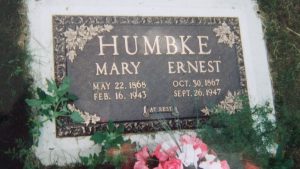Blog 9, 26 DEC 2016: Mary Westenfeld becomes wife of Ernest Humbke Sr. 1902 Duhamel, Alberta
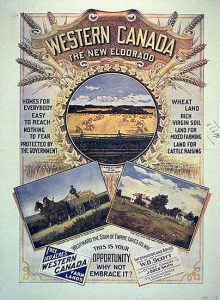
“Mary”, born Maria Louise Sophie Lesette Westenfeld, on 22 MAY 1868 at #19 Windheim Village, Germany to Ernst Friedrich Wilhelm Westenfeld b. 15 APR 1840 & Wilhelmine Sophie Luise Westenfeld (Hothan) b. 06 JUL 1840, m. 28 NOV 1860, was one of ten children.
MARY HUMBKE LEAVES GERMANY IN 1902 for a HOMESTEAD near Wetaskiwin, Alberta, CANADA
In 1901 (age 33) Mary was a “Spinster”, bordering on becoming an “Old Maid” living in Bremen, Germany, when a letter arrived at Windheim Village in Germany from one of the village’s sons.
Fifteen year old Ernest Humbke Sr. had left German on his own in 1872, to find his fortune and fame in the new world, but he was getting worried.
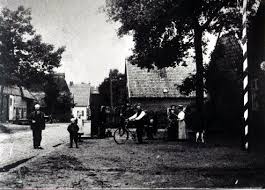
Twenty years had passed, and he was still single at age 34. His two younger sisters were married and although he had started successful homesteads in both South Dakota and Canada, as well as bought a farm in Iowa, Ernest had yet to start his own family. In desperation he wrote home to the village asking if there was anyone from his confirmation group that would come to North America and marry him.
At that time men were often very authoritarian and Ernest Sr. was such a man. Times were hard and he was stern, demanding and made all important decisions. It may have been what was required in a family and to his credit the Humbke family survived and prospered. One story told by family is that upon meeting Mary in New York, Ernest Sr. went into a cafe and ate a meal, while leaving Mary alone on a bench outside.
Mary had her own challenges and rumour has it that the man she was to marry had either jilted her or was having an affair with another women. She had been in the same confirmation class as Ernest Sr, and for her, his letter was the answer to all her problems. She made plans to catch the first ship for America.
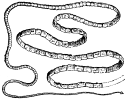
All was not bliss on the ocean voyage as Mary was infected by a tapeworm, around the time of her departure, and nearly died during the Atlantic crossing. When she arrived she was gaunt, 40 pounds lighter, and seriously ill. She had sent her future husband a photo and told him she would be wearing a red flower for identification. Lucky thing, as the only thing he could identify was the “flower”.
Ernest had left the North West Territories of Canada on Jan. 2, 1902 and gone by way of Iowa to met Mary’s ship in New York. He nursed her, mainly by getting her to drink a mixture of buttermilk 3 to 4 times a day, until the tape worm was killed and she had gained enough weight to start the long trip to her new home. They arrived at their homestead 14 miles West of Wetaskiwin around April 14, 1902.
1902 MARY WESTENFELD MARRIES ERNEST HUMBKE IN DUHAMEL
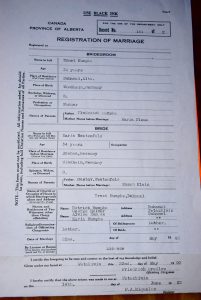
The marriage took place a month later on May 22, 1902 in Duhamel. They must have still been dizzy from the trip because on the Marriage Registration, Ernest has his father as being Frederick Humpke and his mother as Maria Flem. Not to be outdone, Mary had her father as Gustava Westenfeld and mother as Susan Klien. Witnesses were brother Ditrich Humpke, friend George Reimer and Ernest’s sisters Maria and Alwine Humpke.
At times I have wondered if our relatives had the habit of using different names to confuse government record keepers regarding conscription and relationships; translation of German names to an English version; or if it was just poor spelling by the clerks.
There no doubt was a wedding dance and celebration as brothers Dick and Ernst had already started and played in German Oompah bands. Music and dances appeared to be the main form of entertainment in the local community.
ERNEST SR AND MARY MOVE FROM THE HOMESTEAD TO A NEW FARM IN 1907
Mary was an ambitious bride and her name appears on the New Berlin School Register as the only adult student 1902 – 1907. It was no doubt an opportunity for her to learn English and assist the teacher of 27 students. As they were 2 1/2 miles to school Mary & her 12 year old sister-in-law, Emma Humbke, rode a horse or took a buggy to school.
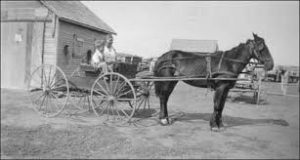
Their original 224 sq. ft. framed house, valued at $150, was on the SE quarter of Section 12, Township 46, Range 2,2 West of the 4th and close to her Mother-in-law’s homestead. It would be the home of Ernest Sr. and Mary and see the arrival of 3 daughters between 1903 and 1907.
In 1907 the family would purchase a farm (NE & SE quarters of Section 35, Township 46, Range 22, West of the 4th) across from the New Berlin School. The girls were to complete their high school education in Wetaskiwin, but the two boys (Ernie 1908 and Lawrence 1911) finished their schooling at the local school.
Siblings of Ernest Sr & Mary Humbke
Erna Louise Humbke: b. 19 Jul 1903; m. Henry Immanuel John Kuring on 19 AUG 1924 in Wetaskiwin.
Elsie Sophia Marie Alvina Humbke: b. 08 APR 1905; m. Daniel J. Hladik on 24 JUL 1935
Martha Emma Augusta Humbke: b. 11 JUN 1906; m. Arnt Kjorlien on 08 SEP 1929 in Green Court, Alberta
Ernest Jr. “Ernie” Dietrich Humbke: b.03 JUN 1908; m. Adeline “Toots” Denton on 11 FEB 1932 in Gwynne
Lawrence Henry Humbke: b. 21 MAY 1911; m. Marvalin Catherine Vanouck 15 NOV 1937 in Duhamel.
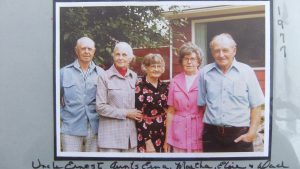
HUMBKE FAMILY MOVES TO EDMONTON IN 1912 AND OPENS A GENERAL STORE.
The family had moved to Edmonton in 1912 where Ernest Sr. had started a store on 118th Avenue. The older girls attended public school, but due to animosity against Germans at the time and decreasing business at the store the family returned to the farm a few years later.
Erna, the family’s first child was 9 years and in 1916 wrote about her experience while attending school in Edmonton. Her younger sisters, Elsie and Martha also contributed stories to THE GRAIN GROWER’S GUIDE published in Winnipeg and distributed throughout the prairies of Canada.
‘A Very Cruel Thing’ June 14, 1916 was an Article by Kristine Moruzi about Canadian Children & The First World War in which she referred to Erna’s writing as “… of a wartime reality that is remarkable for a girl of her age and experience.”
On Sept 20, 1916 on the subject of why she didn’t like school, Erna tells a sad story of her friendless existence at school where she was bullied by other children and was often the victim of false accusations. A short time after these events she writes;
“We moved to Edmonton but here I fared worse. The girls would not play with me because I was German, altho [sic] I could not help that. They always called me ‘Old Dutchy’. I remember only too well the many times I cried because of this. There were other Germans in school, but they were better dressed and therefore better treated.” YCC 20 Sept 1916: p. 24
The reference to her German ancestry, as well as the economic indicators associated with her dress, reflect the discrimination she faced as poor girl of German ancestry in wartime. Upon her return to the farm, it is unclear if she returned to the same school or wen elsewhere, but circumstances were greatly improved since.
“I like school fine here and have agreed with all my teachers and they have been good to me” YCC 2o Sept 1916: p. 24
 The school she returned to was New Berlin, but the name was changed in 1917 to Verdun (after a Canadian Battlefield in WWI) for fear that the school may be burned down.
The school she returned to was New Berlin, but the name was changed in 1917 to Verdun (after a Canadian Battlefield in WWI) for fear that the school may be burned down.
After finishing grade 8 at Verdun, Erna, Elsie and Martha Humbke would all complete their highs school in Wetaskiwin before going to Camrose Normal School and become teachers in one room schools in rural Alberta.
MARY’S LIFE IN CANADA
In talking with Mary’s grandchildren, I heard that she was a short 5′ 2″ very gentle, kind person who people had nothing but compliments for. She often invited her grandchildren to her home for tea and treats as they attended school just across the road. Mary excelled at baking bread and cooking meat for her family.

Mary had come from what at that time was a modern, cultured city in Germany to the virgin wilderness of the Canadian prairies where she spent the next 42 years building both an exemplary family and community. The isolation of the Prairies are best expressed in the the book and movie of the same name “The Homesman”. I suggest you watch the movie which took place on the American plains just South of the original Humbke homestead in South Dakota and depic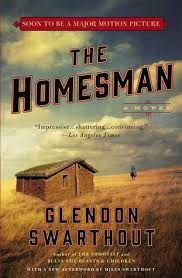 ts just how difficult it was for women to keep their sanity. In all my research I have not found any indication of mental illness and feel it must be because our families were large and composed of a number of adults and children who supported each other in both work and play.
ts just how difficult it was for women to keep their sanity. In all my research I have not found any indication of mental illness and feel it must be because our families were large and composed of a number of adults and children who supported each other in both work and play.
In 1936-37 her husband went on a 6 month trip with his brother to visit relatives in the States and Mary stayed behind to look after the family. She never complained and rose to all challenges that came her way. Her daughters and sons in turn raise raise responsible, respectable families that were a tribute to the community. Her dream in old age was to move to a small house in the city, but fate would prove different.
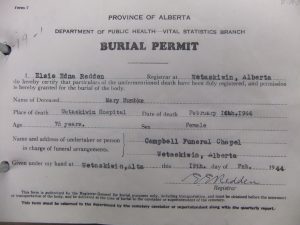
On 16 Feb 1944 at the age of 75, Mary Humbke passed away in the Wetaskiwin hospital from blood poisoning as a result of stepping on a rusty nail on their farm. In later life she had become quite forgetful and was living with her daughter, Dan and Elsie Hladik and their children Jackie and Wayne.
